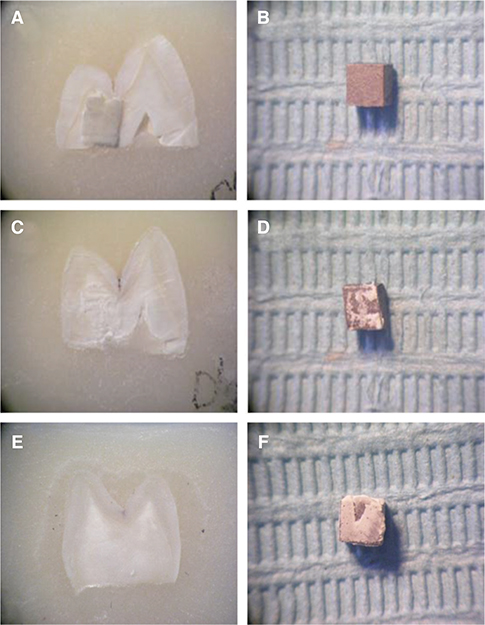J Adv Prosthodont.
2017 Dec;9(6):447-452. 10.4047/jap.2017.9.6.447.
Effects of Hybrid Coat on shear bond strength of five cements: an in vitro study
- Affiliations
-
- 1Department of Stomatology, The Second Xiangya Hospital, Central South University, Changsha, Hunan, China. yunzhifeng81@163.com
- 2Department of Metabolism & Endocrinology, National Clinical Research Center for Metabolic Disease, the Second Xiangya Hospital, Central South University, Changsha, Hunan, China. houdezhou@csu.edu.cn
- KMID: 2398049
- DOI: http://doi.org/10.4047/jap.2017.9.6.447
Abstract
- PURPOSE
To evaluate the sealing performance of Hybrid Coat and its influence on the shear bond strength of five dentin surface cements.
MATERIALS AND METHODS
Six premolars were pretreated to expose the dentin surface prior to the application of Hybrid Coat. The microscopic characteristics of the dentinal surfaces were examined with scanning electron microscopy (SEM). Then, 40 premolars were sectioned longitudinally, and 80 semi-sections were divided into a control group (untreated) and a study group (treated by Hybrid Coat). Alloy restoration was bonded to the teeth specimen using five different cements. Shear bond strength was measured by the universal testing machine. The fracture patterns and the adhesive interface were observed using astereomicroscope.
RESULTS
SEM revealed that the lumens of dentinal tubules were completely occluded by Hybrid Coat. The Hybrid Coat significantly improved the shear bond strength of resin-modified glass ionomer cement (RMGIC) and resin cement (RC) but weakened the performance of zinc phosphate cement (ZPC), zinc polycarboxylate cement (ZPCC) and glass ionomer cement (GIC).
CONCLUSION
Hybrid Coat is an effective dentinal tubule sealant, and therefore its combined use with resin or resin-modified glass ionomer cements can be applied for the prostheses attachment purpose.
Keyword
MeSH Terms
Figure
Reference
-
1. Mantzourani M, Sharma D. Dentine sensitivity: past, present and future. J Dent. 2013; 41:S3–17.2. Farias D, Walter R, Swift EJ Jr. Critic appraisal. Postoperative sensitivity with indirect restorations. J Esthet Restor Dent. 2014; 26:208–213.3. Thanatvarakorn O, Nakashima S, Sadr A, Prasansuttiporn T, Thitthaweerat S, Tagami J. Effect of a calcium-phosphate based desensitizer on dentin surface characteristics. Dent Mater J. 2013; 32:615–621.4. Han L, Okiji T. Dentin tubule occluding ability of dentin desensitizers. Am J Dent. 2015; 28:90–94.5. Magne P. Immediate dentin sealing: a fundamental procedure for indirect bonded restorations. J Esthet Restor Dent. 2005; 17:144–154.6. Magne P, Kim TH, Cascione D, Donovan TE. Immediate dentin sealing improves bond strength of indirect restorations. J Prosthet Dent. 2005; 94:511–519.7. Carvalho AO, Oliveira MT, Nikaido T, Tagami J, Giannini M. Effect of adhesive system and application strategy on reduction of dentin permeability. Braz Oral Res. 2012; 26:397–403.8. Yim NH, Rueggeberg FA, Caughman WF, Gardner FM, Pashley DH. Effect of dentin desensitizers and cementing agents on retention of full crowns using standardized crown preparations. J Prosthet Dent. 2000; 83:459–465.9. Reis A, Loguercio AD, Manso AP, Grande RH, Schiltz-Taing M, Suh B, Chen L, Carvalho RM. Microtensile bond strengths for six 2-step and two 1-step self-etch adhesive systems to enamel and dentin. Am J Dent. 2013; 26:44–50.10. Wolfart S, Linnemann J, Kern M. Crown retention with use of different sealing systems on prepared dentine. J Oral Rehabil. 2003; 30:1053–1061.11. Violich DR, Chandler NP. The smear layer in endodontics - a review. Int Endod J. 2010; 43:2–15.12. Cummins D. Dentin hypersensitivity: from diagnosis to a breakthrough therapy for everyday sensitivity relief. J Clin Dent. 2009; 20:1–9.13. Tani C, Finger WJ. Effect of smear layer thickness on bond strength mediated by three all-in-one self-etching priming adhesives. J Adhes Dent. 2002; 4:283–289.14. Faus-Matoses I, Solá-Ruiz F. Dental preparation with sonic vs high-speed finishing: analysis of microleakage in bonded veneer restorations. J Adhes Dent. 2014; 16:29–34.15. Oliveira SS, Pugach MK, Hilton JF, Watanabe LG, Marshall SJ, Marshall GW Jr. The influence of the dentin smear layer on adhesion: a self-etching primer vs. a total-etch system. Dent Mater. 2003; 19:758–767.16. Nakabayashi N, Kojima K, Masuhara E. The promotion of adhesion by the infiltration of monomers into tooth substrates. J Biomed Mater Res. 1982; 16:265–273.17. Nikaido T, Nakaoki Y, Ogata M, Foxton R, Tagami J. The resin-coating technique. Effect of a single-step bonding system on dentin bond strengths. J Adhes Dent. 2003; 5:293–300.18. Takahashi R, Nikaido T, Ariyoshi M, Kitayama S, Sadr A, Foxton RM, Tagami J. Thin resin coating by dual-application of all-in-one adhesives improves dentin bond strength of resin cements for indirect restorations. Dent Mater J. 2010; 29:615–622.19. Aggarwal M, Foley TF, Rix D. A comparison of shear-peel band strengths of 5 orthodontic cements. Angle Orthod. 2000; 70:308–316.20. Piwowarczyk A, Lauer HC, Sorensen JA. In vitro shear bond strength of cementing agents to fixed prosthodontic restorative materials. J Prosthet Dent. 2004; 92:265–273.21. Peutzfeldt A, Sahafi A, Flury S. Bonding of restorative materials to dentin with various luting agents. Oper Dent. 2011; 36:266–273.22. Swift EJ Jr, Wilder AD Jr, May KN Jr, Waddell SL. Shear bond strengths of one-bottle dentin adhesives using multiple applications. Oper Dent. 1997; 22:194–199.23. Yilmaz Y, Dalmis A, Gurbuz T, Simsek S. Retentive force and microleakage of stainless steel crowns cemented with three different luting agents. Dent Mater J. 2004; 23:577–584.24. Atsuta M, Abell AK, Turner DT, Nakabayashi N, Takeyama M. A new coupling agent for composite materials: 4-methacryloxyethyl trimellitic anhydride. J Biomed Mater Res. 1982; 16:619–628.
- Full Text Links
- Actions
-
Cited
- CITED
-
- Close
- Share
- Similar articles
-
- Effect Of Dentin Desensitizers On Shear Bond Strength Of Resin Cements
- SHEAR BOND STRENGTH OF LUTING CEMENTS TO DENTIN TREATED WITH RESIN BONDING AGENTS
- The shear bond strength of two adhesives bonded to composite resin and glass ionomer cement restorations
- The effect of surface treatment conditioning on shear bond strength between zirconia and dental resin cements
- In vitro shear bond strength of ceramic brackets




